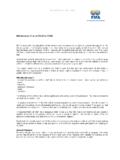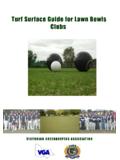Transcription of Zinc in turf grass - NC Turf Support
1 COMMON GROUND. zinc in turf grass zinc is a plant essential nutrient, necessary for plant growth of 50 ppm. The total zinc acts like a reservoir of potentially and is taken up by the plant in the form of a cation, Zn++. available zinc . The availability of the reservoir is dependent It is utilized in the following processes; activation of on the pH and organic matter. Most zinc minerals are enzymes, chlorophyll formation, growth hormone contained in the silt and clay fraction of the soil. Therefore, regulation, cell growth and seed formation. Since zinc is medium and fine textured soil usually has higher levels of immobile in the plant, visual deficiency symptoms zinc and less prone to zinc deficiency then sandy-textured or (interveinal yellowing) will be most prominent in newly sand constructed soil. emerged tissue. Phosphorus Research has shown that phosphorus fertilizer Factors Affecting zinc Availability can induce zinc deficiencies.
2 Although, only when soil test levels are low to marginal (< ppm Zn). With these low Soil pH The solubility and availability of zinc is directly levels high phosphorus applications will intensify a zinc related to soil pH. In alkaline soil, solubility is low and deficiency. If the soil test zinc is > the ppm, then increases as the soil becomes more acidic. The table below phosphorus induced zinc deficiency will not occur. predicts zinc concentration at various pH levels. For every one pH unit change, the soil zinc changes one-hundredfold. Soil temperature and moisture Cold, wet soil reduces root growth, zinc uptake, zinc solubility and zinc released from Soil pH Soil Zn ppm soil organic matter. As a result, the most severe zinc deficiencies occur in cold, wet and poorly drained soil. Diagnosing Deficiencies Soil Analysis The extract most commonly used for zinc is DTPA, which is a chelate.
3 The critical level for DTPA. extractable zinc is approximately to ppm. A value Organic Matter zinc deficiencies are frequently associated less than would be considered deficient. The process of with soil low in organic matter. Soil organic matter interpreting a zinc soil test can be improved when other behaves much like a chelate in holding zinc in the soil. factors that affect zinc availability (factors above The chelating process of organic matter protects zinc from mentioned). For example, a soil-test level of ppm would reacting with other soil minerals that contribute to zinc be an adequate form of a slightly acid medium textured soil, tie-up . zinc accumulates in the topsoil with soil organic with an organic matter level of 2%. However, a ppm matter because of the organic matter's strong attraction to zinc level would definitely be deficient on an alkaline sand zinc . Because of this, areas with a high degree of dirt work soil with organic matter less than 1%.
4 (cutting and filling) or heavy erosion are most prone to zinc deficiencies. This is further exaggerated when the newly Application rates of zinc , will be regulated by the types and exposed subsoil is alkaline. grades of fertilizer materials used. If needed, buy a fertilizer material containing zinc and follow the label for the correct Constructed sand based soils, are by design, low in organic rate. As noted above, zinc should be applied with the first matter. Generally, the organic material used in an 80:20. application of the growing season, when soil temperatures mix is organic residue not fully decomposed organic matter. are cool. Meaning, that the reactivity is very low without continued applications of this organic residue, short lived (depending Plant Analysis Since many factors can affect zinc on geography, to 3 years) in the soil. availability, a plant tissue sample is an excellent diagnostic tool to complete a fertility monitoring program.
5 This tool Total zinc contest The original minerals present during allows the user to observe the actual zinc concentration in soil formation determine the total zinc concentration in the the plant. You can better evaluate whether the plant is soil. The total zinc content of the soil (available plus getting enough zinc or if too much zinc is present in the soil. unavailable) can range from 10 to 300 ppm with an average Critical zinc levels for some turf grasses; Bermudagrass, 50 . 80 ppm, Bluegrass 40 60 ppm, Bentgrass 80 120 ppm. As toxicity may not occur it is important to identify a result of the equilibrium, phosphate anion concentrations in where the zinc is coming from (fertilizers, irrigation the soil solutions are created. Phosphorus is absorbed by the water, top dress materials; sand or organic compost plant directly from the soil solution, in the forms of H2PO4, or from fungicide applications) and eliminate the HPO4 or PO4.
6 Thus, soil solution phosphorus is actually the source. These high levels may or may not decline over the years, but it is important to keep zinc from source of phosphorus for plants even though the bulk of the getting higher. reserve is found in the soil organic matter and mineral forms. The concentration of the soil solution increases if there is Conclusion more released than removed. Conversely, the concentration decreases if there is more removal than release. zinc deficiencies in turf grass are quite common through out the This is particularly true with Toxicities constructed sand soils. Correction can be accomplished with zinc fertilizer applications and in Toxicities of zinc have not been document in turf grasses. some circumstances acidifying the soil itself will be Research studies included application rates of up to 1000. helpful. Remember zinc is a metal and leaches little pounds/acre, with no negative affect.
7 However, very high over time. In addition, plant uptake of zinc is levels of zinc are common, particularly in areas of intensive approximately to pounds per acre. So turf management (golf greens). Laboratory levels of 50 to systematic monitoring is needed to determine when 100 ppm are common in older golf courses (older than 10. to stop applying zinc . years) have been reported. Even though an agronomic




